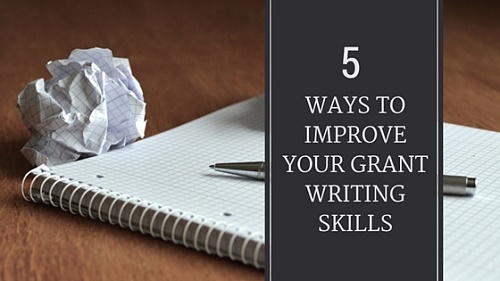Grant writing is no easy task. It takes research, organization, dedication and creativity to craft a grant proposal that entices reviewers to keep reading for further information – and ultimately give the green light for funding.

5 Tips to Improve Your Grant Writing Skills
Want to improve your grant writing skills for maximum success? Try the following tips:
1. Review the Guidelines Carefully
While grants usually require the same information, it’s still a good idea to review the guidelines of each grant you are applying for. This will help you put together your proposal, including an outline to get you started, and ensure you send in all the necessary information.
2. Write an Outline
Using your grant guidelines, you can put together an outline that details all the sections needed for a complete grant proposal. Typical grant proposals include: Letter of Inquiry or Cover Letter, Executive Summary, Statement of Need, Goals and Objectives, Program Design or Methodology, Evaluation, Project Sustainability, Nonprofit Organization Information, and Budget.
Within your outline, write notes about specific items that should be addressed under a certain section or add details about where you’re going to get information regarding a key point to keep yourself organized. You can also give each section a due date to keep the grant writing process moving – and help you meet the final deadline.
3. Simplify
You can write the best grant proposal out there, but it won’t mean anything if no one can read or understand it. Simplify your writing using these tips:
- Avoid vague words and empty phrases – Ex: nearly, almost, about, or roughly
- Don’t use jargon, technical language, acronyms, or clichés
- Don’t use words you wouldn’t use in normal, everyday talk, meaning there is no need for a thesaurus
- Use short words, short sentences, and short paragraphs to help readers follow along and stay engaged
- Use charts and graphs to help explain your points – these also help break up text and make documents easier to read
- Use headings and subheadings to help control the flow of your proposal, and let readers know they are entering a new section or a sub-section of content
4. Organize the Budget
The budget is probably the most crucial aspect of your grant proposal. It can determine whether your project is brought to life, or left on paper. To make your budget easier to read and understand:
- Use clear and concise verbiage to explain how much each activity will cost, and how to relates to the overall project
- Convey realistic expectations of how much items/activities may cost
- Show detailed sources of income and expenses for the life of the project
- Review the numbers to make they add up and make sense
5. Proofread!!!
Before you submit your well-researched and organized grant proposal, review your document for spelling, grammar and punctuation errors, in addition to checking for the necessary proposal guidelines.
Even better, ask a co-worker to proofread the proposal for you. Ask them to review the flow and organization of the document, in addition to giving general editing feedback. They may have additional insight that can make your proposal more transparent.
**Bonus Tip: Be Creative!
Many times grant proposals come across as boring. Liven up your organization’s request by using creative language that tells YOUR story to pique the interest of those dispersing the money.
Share what makes your organization unique, and what about your project is going to benefit the people/audience/etc. its geared to.
Want to Improve Grant Funding for Your Organization?
Are you ready to simplify and organize your grant management process? Capital Business Solutions is a reseller for Abila Grant Management, allowing you to increase grant funding, stay organized and measure success. Request more information on Abila Grant Management by calling 919-821-1244 or filling out our online contact form.